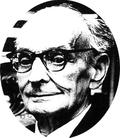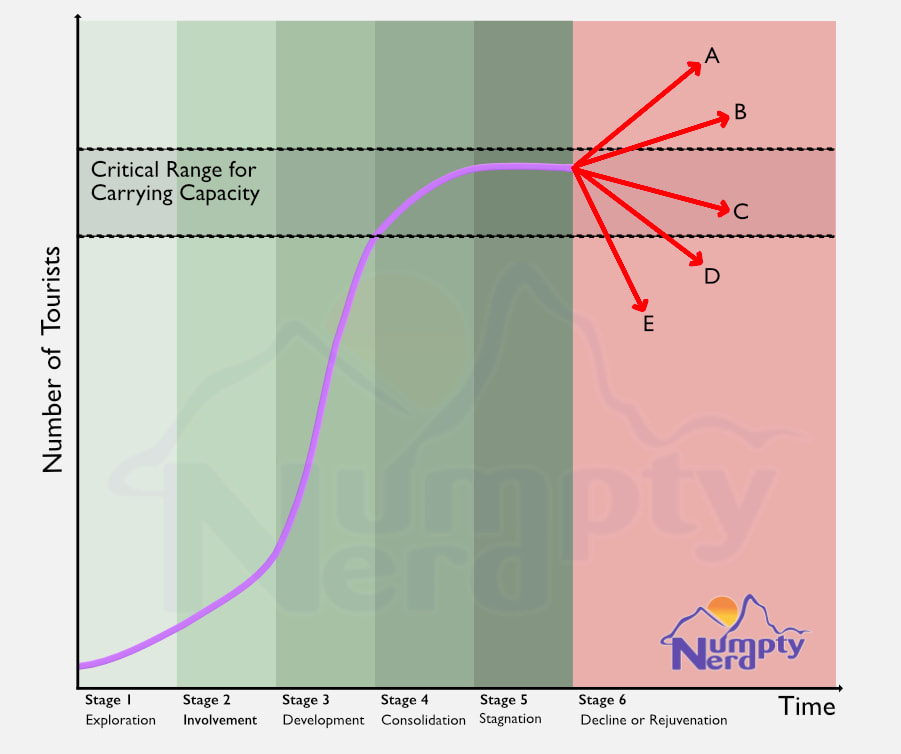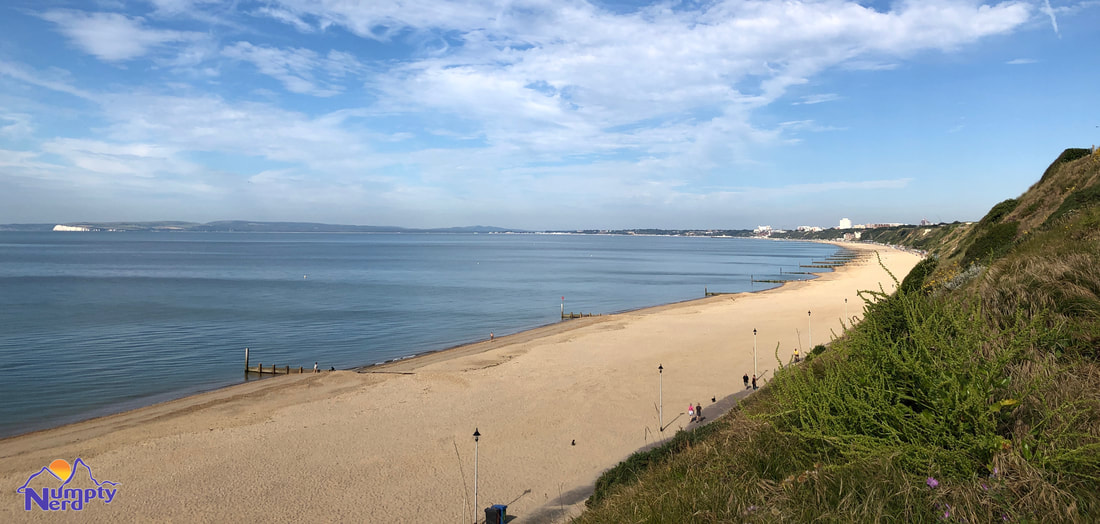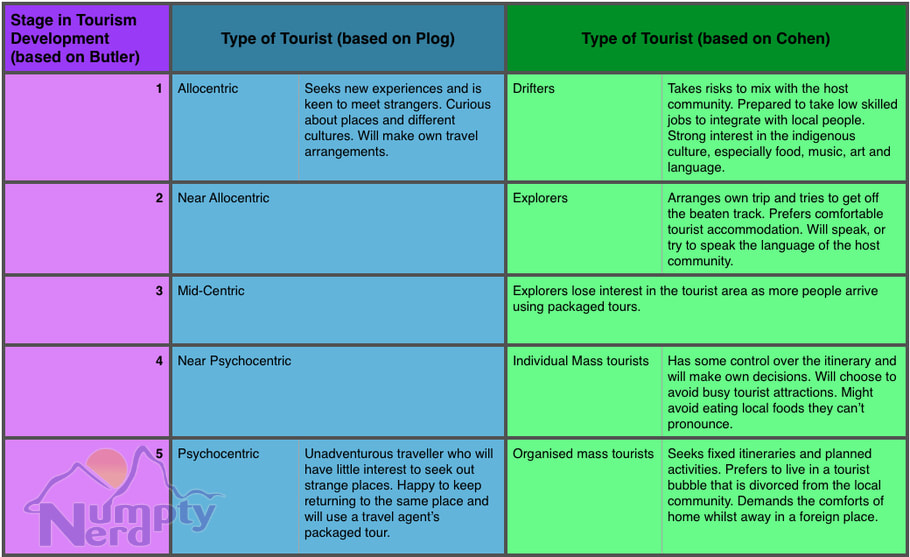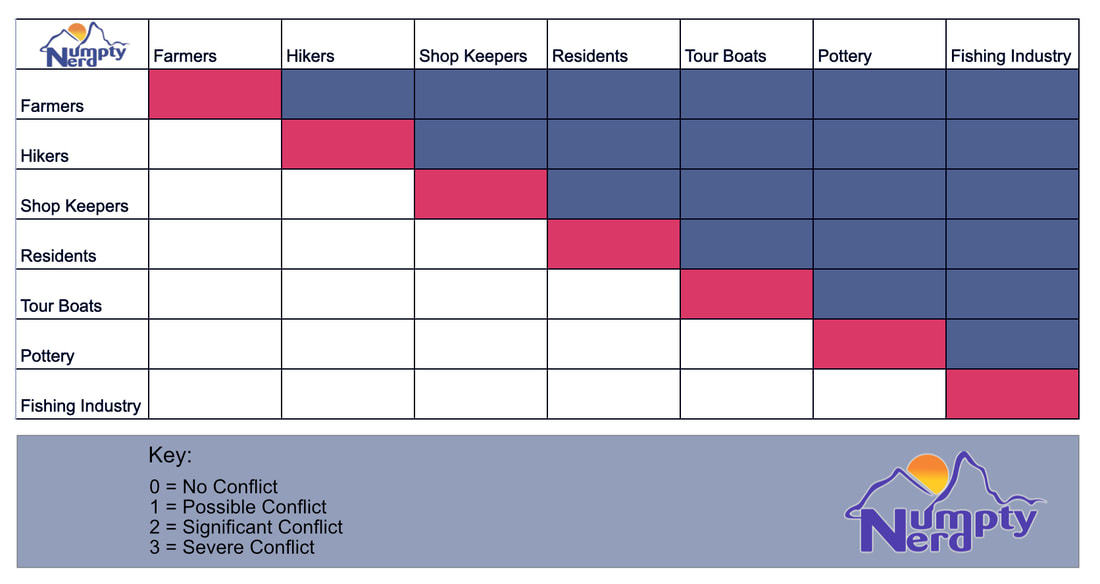The Butler Model of Tourism Development
Updated: February, 2024
Prof. Richard W. Butler's work in 1980 initiated a discourse on tourism carrying capacity and sustainability. He observed that tourism attractions are delicate and require careful management to ensure they do not exceed their capacity limits. After all, who would want to stay at a resort that feels overcrowded and over-commercialised? As Butler emphasises, tourism destinations contain the inherent potential for their own demise. The challenge lies in managing these destinations to prevent them from self-destructing.
Butler (1980) describes a tourism cycle comprising six stages. However, in the sixth stage, Butler delineates a spectrum of five potential outcomes, ranging from complete rejuvenation to total decline. Figure 1 (see below) is an interpretation of the original model, as published in 'The Canadian Geographer.'
Butler (1980) describes a tourism cycle comprising six stages. However, in the sixth stage, Butler delineates a spectrum of five potential outcomes, ranging from complete rejuvenation to total decline. Figure 1 (see below) is an interpretation of the original model, as published in 'The Canadian Geographer.'
The tourism cycle of development provides a great opportunity for undertaking fieldwork. For a particular tourism area, you can collect data to locate its position in Butler's model of tourism development. Start by studying each of the stages below and then consider the types of data you might collect that are relevant to the Butler model.
The Six Stages of Tourist Area Evolution
|
1: The Exploration Stage
2: The Involvement Stage
3: The Development Stage
4: The Consolidation Stage
5: The Stagnation Stage
|
The Final Stage of the Butler Model
After reaching stagnation, Butler saw that rejuvenation or decline as possible alternatives. The last stage of his model offers five scenarios between complete rejuvenation and total decline: A: Successful redevelopment leads to renewed growth. B: Minor modifications to capacity levels lead to modest growth in tourism. C: Tourism is stabilised by cutting capacity levels. D: Continued overuse of resources and lack of investment leads to decline. E: War, disease or other catastrophe causes an immediate collapse in tourism. Stage 6: The Decline Scenario
Stage 6. The Rejuvenation Scenario
According to the 1980 Butler model, tourism areas leaving stage five, will either decline or rejuvenate - either way, the tourism area has evolved into the sixth stage of its development. It is misleading to identify a seventh stage in Butler's model.
|
Opportunities for Fieldwork and Research
Finding a tourism area and gathering evidence to show what stage it might be in the Butler model is a great opportunity to conduct fieldwork and online research.
Make life easy for yourself and choose a small tourist area. A small seaside resort or a village in a national park is likely to get you better results than ambitious plans to asses the whole of a major island, such as Bali.
All fieldwork should begin with a risk assessment that is concerned with protecting your safety. Students under the age of 18 should inform their parents and teachers before undertaking any kind of fieldwork investigation.
Make life easy for yourself and choose a small tourist area. A small seaside resort or a village in a national park is likely to get you better results than ambitious plans to asses the whole of a major island, such as Bali.
All fieldwork should begin with a risk assessment that is concerned with protecting your safety. Students under the age of 18 should inform their parents and teachers before undertaking any kind of fieldwork investigation.
|
Online Research
First, create a place profile of the tourism area. Gather some basic information and make some sketch maps - don't forget essentials, like a scale and compass bearing. The place profile can be structured to summarise formal (quantitative) data from governments, NGOs and business players in the tourism sector. Informal (qualitative) data can also be collected from blogs and travel websites where tourists often make candid comments about their tourism experiences. Examples include Travelfish and Tripadvisor. If people are moaning and say the resort has seen better days, this maybe an indication of decline. Use wordle.net (figure 2) to see if there are any common themes in what people say. |
Tai O, Hong Kong - Many tourism destinations develop a "brand" image to attract particular types of tourists.
|
Butler makes reference to advertising and marketing as a factor in tourism development. Looking at travel websites will provide you with evidence of how a place is being marketed. The way a tourism product is being marketed might provide you with evidence of the type of tourist they seek to attract (see figure 3 below). For example, a resort might seek to boost visitor numbers by appealing to the mass market by competing mainly on price. In contrast, some tourism spots market themselves as elite destinations for the more discerning traveller.
|
NumptyNerd provides high-level revision materials that include exemplar essays and a carefully selected collection of relevant YouTube videos for when you need a break from reading.
|
Fieldwork
|
Your aim is to gather data to assess what stage your chosen tourism area has reached. You should use a range of fieldwork techniques and avoid relying on just doing a questionnaire. Whatever techniques you use, remember that this is not physical geography - you are dealing with people, not rocks.
Tourism Questionnaire Using inspiration from the table below, it is possible to develop your own questionnaire or interviews to find out what types of tourist visit your fieldwork study area. Obviously, you won't ask tourists if they are "allocentric or "psychocentric", but you might ask tourists if they have eaten any of the local foods. Your questions should be sensitive but will hopefully reveal something about the type of visitor to your study area. |
Butler refers to both Plog and Cohen who have done research on different types of tourist. Butler's assumption is that, as a tourist area evolves, the range of tourist types present will change inline with changes to the tourism area. Figure 3, the table above, is Numpty Nerd's interpretation of Plog and Cohen. However, caution and judgement should be exercised when matching these types of tourist with each stage of development. Butler is vague on this, so you have some wiggle-room here.
You should also incorporate questions that are just for local residents. Here the point of your questionnaire is to find out if the local population are happy with tourism developments. By stage four of the model, Butler argues that many locals will show signs of discontent - especially if they are not getting an income from tourism. It is reasonable to ask if residents work in the tourism sector. Avoid asking how much they earn or what their exact role is.
Your questionnaire will also ask how far people have travelled to your study area. Information from this question should then be mapped out as a sphere of influence or journey map. This information must then be matched with further questions about length of stay - day tripper, weekender or holidaymaker. In your analysis, this information needs to be carefully matched with the Butler model.
Carrying capacity
Carrying capacity is an important part of the Butler model and this should be reflected in your questionnaire. Perceptual carrying capacity is about tourism experience and relates to the feeling that the area maybe overcrowded, or not. Your questionnaire should have questions designed to gage perceptions regarding visitor numbers and overcrowding. Your questionnaire could be supplemented by gathering quantitative data about the number of people walking down particular streets (footfall) or the number of people queuing to enter key tourism attractions. If appropriate, you might want to estimate the density of tourists on a section of beach.
You should also incorporate questions that are just for local residents. Here the point of your questionnaire is to find out if the local population are happy with tourism developments. By stage four of the model, Butler argues that many locals will show signs of discontent - especially if they are not getting an income from tourism. It is reasonable to ask if residents work in the tourism sector. Avoid asking how much they earn or what their exact role is.
Your questionnaire will also ask how far people have travelled to your study area. Information from this question should then be mapped out as a sphere of influence or journey map. This information must then be matched with further questions about length of stay - day tripper, weekender or holidaymaker. In your analysis, this information needs to be carefully matched with the Butler model.
Carrying capacity
Carrying capacity is an important part of the Butler model and this should be reflected in your questionnaire. Perceptual carrying capacity is about tourism experience and relates to the feeling that the area maybe overcrowded, or not. Your questionnaire should have questions designed to gage perceptions regarding visitor numbers and overcrowding. Your questionnaire could be supplemented by gathering quantitative data about the number of people walking down particular streets (footfall) or the number of people queuing to enter key tourism attractions. If appropriate, you might want to estimate the density of tourists on a section of beach.
Land Use Mapping
A land use map will provide a good indication of what stage your study area has reached. Butler states that resort areas with a well-defined recreational business district is a characteristic feature of stage four.
Start with a good base map of the study area, a GIS should help. The more information you mark on the map in the field the better. After you have completed land use mapping you will need to classify land use according to primary and secondary tourism attractions. Remember also, that non-tourist land use is just as important when assessing tourism development. According to Butler, the evolution of a tourism area will be characterised by an expansion of secondary tourism attractions.
A land use map will provide a good indication of what stage your study area has reached. Butler states that resort areas with a well-defined recreational business district is a characteristic feature of stage four.
Start with a good base map of the study area, a GIS should help. The more information you mark on the map in the field the better. After you have completed land use mapping you will need to classify land use according to primary and secondary tourism attractions. Remember also, that non-tourist land use is just as important when assessing tourism development. According to Butler, the evolution of a tourism area will be characterised by an expansion of secondary tourism attractions.
Environmental Quality Survey (EQS)
Taylor your environmental quality survey to show the impact of tourism on the environment. By stage five, Butler argues that tourism will be causing significant environmental impacts. The EQS is not a questionnaire and is best completed by the same person to ensure consistency. A common mistake is to complete the EQS only once. Ideally, you should repeat your survey many times - the more the better. Each time you use your survey you should record the location so that you can map the scores. If you have 40-50 EQS readings across your study area, you will be doing well. Click here to download Numpty Nerd's guide to environmental quality surveys.
Taylor your environmental quality survey to show the impact of tourism on the environment. By stage five, Butler argues that tourism will be causing significant environmental impacts. The EQS is not a questionnaire and is best completed by the same person to ensure consistency. A common mistake is to complete the EQS only once. Ideally, you should repeat your survey many times - the more the better. Each time you use your survey you should record the location so that you can map the scores. If you have 40-50 EQS readings across your study area, you will be doing well. Click here to download Numpty Nerd's guide to environmental quality surveys.
Participant Observation
Relax! Stop being a geographer and get into holiday mode and step into the shoes of a tourist. Put away that intimidating clipboard that makes people wonder if you might be working for the government and start looking and behaving like a tourist. You need to experience the main tourism attractions for yourself. Plan to eat some of the local food. Soak up the resort and get a fuller, rounder, perspective on your study area.
Professional geographers who conduct participant observation will normally jot down scratch-notes. A mobile phone is a useful tool to discreetly take rough notes which can then be expanded to write a more lucid journal as soon as you get home. Write your journal in the genre of being a tourist - don't write in an academic style. In your fieldwork report (which must be written in an academic style) you can quote short extracts from your journal as evidence.
Photography
Geographers and tourists both love taking photographs - so make sure you take your camera. Aim to take plenty of photographs so that you can find the right shot to support your analysis. Take note of the 100:1 rule - for every hundred snaps you take, only one might be good enough to support your fieldwork report.
Make sure you take some photographs that are suitable for adding labels and annotations. Panoramic or "pano" shots are ideal for this and will go a long way to impress whoever reads your fieldwork report. Click here for advice about boosting your grade when using photographs and captions in your fieldwork report.
Relax! Stop being a geographer and get into holiday mode and step into the shoes of a tourist. Put away that intimidating clipboard that makes people wonder if you might be working for the government and start looking and behaving like a tourist. You need to experience the main tourism attractions for yourself. Plan to eat some of the local food. Soak up the resort and get a fuller, rounder, perspective on your study area.
Professional geographers who conduct participant observation will normally jot down scratch-notes. A mobile phone is a useful tool to discreetly take rough notes which can then be expanded to write a more lucid journal as soon as you get home. Write your journal in the genre of being a tourist - don't write in an academic style. In your fieldwork report (which must be written in an academic style) you can quote short extracts from your journal as evidence.
Photography
Geographers and tourists both love taking photographs - so make sure you take your camera. Aim to take plenty of photographs so that you can find the right shot to support your analysis. Take note of the 100:1 rule - for every hundred snaps you take, only one might be good enough to support your fieldwork report.
Make sure you take some photographs that are suitable for adding labels and annotations. Panoramic or "pano" shots are ideal for this and will go a long way to impress whoever reads your fieldwork report. Click here for advice about boosting your grade when using photographs and captions in your fieldwork report.
SWOT Analysis
 Fig. 4 - A SWOT analysis looks easy but is often done badly.
Fig. 4 - A SWOT analysis looks easy but is often done badly.
A SWOT analysis looks easy but is often done badly.
Remember that strengths and weaknesses are the things that are already present. Whilst opportunities and threats are about what might happen in the future.
Applying your SWOT to the Butler model could be tricky, so make sure you gather evidence to construct your SWOT analysis.
- In the early stages of the model it is reasonable to expect that strengths and opportunities outweigh weaknesses and threats.
- In the later stages which are characterised by stagnation and decline, expect weaknesses and threats to dominate.
Tourism Conflict Matrix
A conflict matrix is a useful tool to summarise the relationship between different people in the local community and tourists. You should devise your own conflict matrix to suit your fieldwork location. There are many online that might give you some inspiration, such as the one below.
Your conflict matrix can be created in three steps:
A conflict matrix is a useful tool to summarise the relationship between different people in the local community and tourists. You should devise your own conflict matrix to suit your fieldwork location. There are many online that might give you some inspiration, such as the one below.
Your conflict matrix can be created in three steps:
- Before undertaking fieldwork, create a provisional matrix based on your online research.
- When you are in the study area, use your field observations to develop the matrix.
- After you have analysed your fieldwork data, you are now in a position to refine your understanding of the relationships between key players in your tourism area.
According to Butler's model, tourism generates increased levels of conflict as it develops and expands with increased visitor numbers. A conflict matrix provides a systematic and organised way to asses the level of conflict in a particular tourism area.
Take care to consider that low levels of conflict might be due to successful tourism management. If you suspect that this is the case then you will need to consider what is being done to manage tourism to prevent tourism conflicts. It is reasonable to expect that tourism management might have improved since 1980 when Butler published his work.
Take care to consider that low levels of conflict might be due to successful tourism management. If you suspect that this is the case then you will need to consider what is being done to manage tourism to prevent tourism conflicts. It is reasonable to expect that tourism management might have improved since 1980 when Butler published his work.
The seeds of their own destruction
The Butler Model is about the (sustainable) development of tourism destinations and the ways these places are being managed (or mismanaged). Butler warns that tourism destinations have the propensity to self-destruct.
Having used the Butler model as a tool to analyse a tourism destination, your data should enable you to comment on the present and future sustainability of that tourism development. Is the resort heading for disaster, or is it being carefully managed to keep numbers within its carrying capacity? Alternatively, is it adverting decline by evolving new attractions that enable it to compete with other tourism destinations?
Today, many tourism destinations are now suffering under the weight of "overtourism" because they have greatly exceeded their carrying capacity. In too many places, tourists are degrading or even destroying the environments that they travel to see and experience. The debate about better tourism management, as raised by the Butler Model in 1980, remains just as relevant today.
Having used the Butler model as a tool to analyse a tourism destination, your data should enable you to comment on the present and future sustainability of that tourism development. Is the resort heading for disaster, or is it being carefully managed to keep numbers within its carrying capacity? Alternatively, is it adverting decline by evolving new attractions that enable it to compete with other tourism destinations?
Today, many tourism destinations are now suffering under the weight of "overtourism" because they have greatly exceeded their carrying capacity. In too many places, tourists are degrading or even destroying the environments that they travel to see and experience. The debate about better tourism management, as raised by the Butler Model in 1980, remains just as relevant today.

